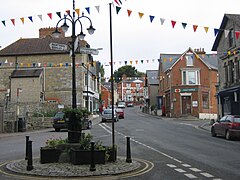Tisbury, Wiltshire
| Tisbury | |
|---|---|
 The Square and High Street |
|
| Tisbury shown within Wiltshire | |
| Population | 2,253 (in 2011) |
| OS grid reference | ST944295 |
| Unitary authority | |
| Ceremonial county | |
| Region | |
| Country | England |
| Sovereign state | United Kingdom |
| Post town | Salisbury |
| Postcode district | SP3 |
| Dialling code | 01747 |
| Police | Wiltshire |
| Fire | Dorset and Wiltshire |
| Ambulance | South Western |
| EU Parliament | South West England |
| UK Parliament | |
| Website | Parish Council |
Tisbury is a large village and civil parish approximately 13 miles (21 km) west of Salisbury in the English county of Wiltshire. With a population at the 2011 census of 2,253 it is a centre for communities around the upper River Nadder and Vale of Wardour. The parish includes the hamlets of Upper Chicksgrove and Wardour.
Tisbury is the largest settlement within the Cranborne Chase and West Wiltshire Downs Area of Outstanding Natural Beauty (larger nearby settlements such as Salisbury and Shaftesbury are just outside it).
The village has some paleoanthropological significance. Evidence of early human activity in the Tisbury area comes from the Middle Gravel at Swanscombe a 400,000-year-old stratum in which skull framents of a young woman was found, the so-called Swanscombe Man. Along with the remains was found several fragments of Pseudodiplocoenia oblonga (also known as Isastraea oblonga), one of four Upper Jurassic species of coral unique to the Upper Portlandian of Tisbury. This indicates that either the group of which Swanscomb Man belonged to traveled to the Tisbury area or were part of a trade network linked to the locality. The coral-bearing chert found at Swanscombe has been interpreted as being intentionally carved to represent the profile of a hominid head, making Tisbury the source of materiel used in what is possibly one of the World's oldest pieces of art.
As in much of the Wiltshire Downs, there is also evidence of Bronze Age settlement. The Tisbury Hoard comprising 114 bronze items, discovered in 2011, is from the 9th to 8th century BC. There are traces of a probable henge monument with some evidence of settlement 3–4000 years ago. To the southeast of the village there is a quite large hill fort. Now known as Castle Ditches this was referred to as Willburge in the charter of 984 A.D. Enclosed within ramparts of the hill fort is a long barrow measuring 60m long, 25m wide and 0.7m high. At that time the village was known as Tisseburi. A stone circle once stood in one of three adjacent fields, one which was known as Lost Stone Field, located near the junction of the Chicksgrove and Chilmark roads. These fields have been joined to form the present Cemetery Field. The last three remaining standing stones, removed in the latter part of the 18th Century now form part of the grotto at Old Wardour.
...
Wikipedia

